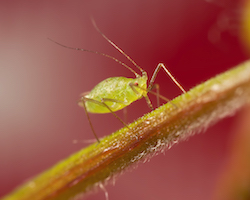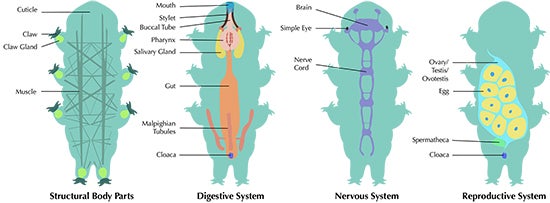What Makes a Tardigrade?
Under a microscope, a drop of water collected from moss or leaves on the forest floor might look like an alien world. You might think, “how can I find a tardigrade in this soup of floating, spinning, and wriggling critters?” Luckily, tardigrades are one-of-a-kind. If you can spot a few important features, you can find your own tardigrades too!

Tardigrades on the Prowl

One trait all tardigrades share is their eight stubby legs. Tardigrades have three legs on each side of the body, and two on the back. The legs often have long, bear-like claws on them. You’d think with eight legs, tardigrades should move pretty fast, but they don’t. Instead, they are slow and clumsy. They hook their claws onto objects like plants or sand, as they move along.
Though they might look silly through a microscope, you would not be laughing if you were tinier than a tardigrade. Tardigrades have round mouths with muscles in their heads that work like cheeks to suck up food. Instead of teeth, they have two terrifying spears. They use these spears, called stylets, to pierce their food and drink the insides like juice. Some tardigrades are plant eaters, but others eat smaller creatures and single-celled organisms. Some even eat other tardigrades.
Tardigrade Anatomy: Same But Different
If you watch a tardigrade wobble around on its little clawed legs and poke things with its pointy face, it might remind you of a tiny hamster. If you looked inside its body, you’d notice one big difference: no tiny bones. Instead, tardigrades have a special “skeleton” that works like a rubber glove filled with water. The liquid that fills tardigrades is called hemolymph, which is full of nutrients, much like our blood.

| Cuticle | A strong but flexible outer covering, similar to skin. |
| Claw | A sharp, curved, pointed structure on a finger, toe, or foot. |
| Claw Gland | A group of cells that release material to grow claws. |
| Muscle | Tardigrades have muscles that attach to their cuticle (they don't have bones). The body muscles move the tardigrade’s legs and body around. |
| Mouth | An opening in the face where food is taken into the body. |
| Stylet | A sharp mouth structure that pierces plant and body tissue so the contents can be sucked out. |
| Buccal Tube | A tube that connects the mouth to the pharynx. |
| Pharynx | A muscular organ that works with the buccal tube to help create suction for feeding. |
| Salivary Gland | A group of cells that can create different chemicals and fluids for the mouth. Some scientists think the salivary glands release materials to grow the stylets. |
| Gut | The place where most food digestion happens, connected to the pharynx. |
| Malpighian Tubule | Where scientists think tardigrade pee is made. These three tubes connect to the gut and remove water, chemicals, and waste from the body fluid - a lot like our kidneys do |
| Brain | A major organ in the nervous system, responsible for controlling many body functions. |
| Simple Eye | A small eye that is made of just a few cells. The cells include sensory cells and a “pigment cup” which has dark-colored granules in it that work like sunglasses. The simple eye is used to sense light. |
| Nerve Cord | A major bundle of nerve fibers that connects nerves throughout the body. It controls movement and other bodily functions. |
| Ovary/Testis/ Ovotestis | The female reproductive organ is the ovary and it makes eggs. The male reproductive organ is the testis, and it makes sperm. Some kinds of tardigrades are both male and female at the same time (hermaphroditic), because they have an ovotestis, which makes both sperm and eggs. |
| Eggs | Female reproductive cells. In asexual tardigrades, these develop into baby tardigrades. In sexual tardigrades, they develop after being fertilized by sperm. |
| Spermatheca | An organ that stores sperm in the female body after mating. |
| Cloaca | The opening through which waste from the gut is removed from the body, and through which sperm and eggs can enter and exit. |
Many tardigrades have long hairs on their bodies that sense the environment, like a cat’s whiskers. They also have simple eyes that notice if it’s light or dark out, but they can’t see color. Just like us, they have guts that hold and digest food, muscles for moving, and brains for thinking. Unlike us, they don’t have lungs, and instead soak up oxygen straight from water.
Additional images via Wikimedia Commons and Flickr. Bear image via Flickr by Tom Pickering.
Read more about: Itty Bitty Beasts
Bibliographic details:
- Article: What Makes a Tardigrade?
- Author(s): Dr. Biology
- Publisher: Arizona State University School of Life Sciences Ask A Biologist
- Site name: ASU - Ask A Biologist
- Date published:
- Date accessed:
- Link: https://askabiologist.asu.edu/tardigrade-anatomy
APA Style
Dr. Biology. (). What Makes a Tardigrade?. ASU - Ask A Biologist. Retrieved from https://askabiologist.asu.edu/tardigrade-anatomy
Chicago Manual of Style
Dr. Biology. "What Makes a Tardigrade?". ASU - Ask A Biologist. . https://askabiologist.asu.edu/tardigrade-anatomy
Dr. Biology. "What Makes a Tardigrade?". ASU - Ask A Biologist. . ASU - Ask A Biologist, Web. https://askabiologist.asu.edu/tardigrade-anatomy
MLA 2017 Style

Tardigrades are sometimes called water bears because of their claws, bulky body, and snout-like mouth. What do you think, do tardigrades look like this bear to you?
Be Part of
Ask A Biologist
By volunteering, or simply sending us feedback on the site. Scientists, teachers, writers, illustrators, and translators are all important to the program. If you are interested in helping with the website we have a Volunteers page to get the process started.


